
Have you found the ideal hairstyle in a magazine or online and cannot wait to have it cut by your stylist? Unfortunately, he or she disagrees and gives you something completely different. Finding the appropriate technique behind the chair will ensure your desired haircut comes to fruition.
Blunt Cutting
A blunt cut refers to straight, un-layered hair. It is an excellent option for women with thin strands looking to add volume, structure, and definition without adding layers to their locks. A blunt cut also works perfectly for thicker locks looking to reduce volume or add design and meaning without losing volume or structure in their waves.
To achieve a blunt cut, your stylist will begin by sectioning the hair into vertical sections of equal length. They’ll use the first section as a guide when cutting each subsequent layer – repeating this process until all hair has been cut off. They mustn’t use tension when cutting hair, which could result in uneven results.
Blunt cuts can work for all bob styles, from the classic chin-length bob to the more dramatic shoulder-grazing silhouette. Consider asking for face-framing layers like bangs to add an extra dimension to your blunt cut. They’ll draw attention to your eyes and cheekbones while covering any facial dissymmetry, whether side-swept or blended into layers – the style options for blunt bangs range from heavy and dull to wispy and can even be styled differently each day!
Another critical benefit of blunt cuts is that they can be worn long and short. If you have long locks, ask your stylist for a sharp pixie cut for a stylish and modern look – this style requires regular trims to avoid unruly strands growing out too rapidly and creating the “rat tail effect.” If you have shorter strands, try a blunt a-line bob for an updated contemporary edge in your haircut. A blunt a-line can provide more volume than traditional bobs due to being cut so that the bottom layer remains longer; add an eye-catching fringe for added drama!
Point Cutting
Point cutting is essential for every hairdresser, as it adds texture, softens hard lines, and reduces bulk. Point cutting can especially be beneficial when working with curly or textured hair, allowing its natural curls and textures to shine through.
Utilizing this technique, you can create various styles by cutting in different directions and blending the ends with longer sections. It also can help generate more full volumes by adding texture and weight at the ends of a short haircut.
Cut hair in small subsections using scissors in a circular motion to achieve a point cut. Moving slowly and deliberately is essential as this technique can produce dramatic results; working slowly requires patience as the results may be surprising. Though sometimes impatience might tempt us, taking your time will ensure the best possible outcome for both the client and the stylist.
When cutting, ensure the tip of your scissors closes upward to avoid cutting off any cuticle that might create frizz or roughen up hair texture. Instead, focus on cutting alongside it by closing upwards with your scissors.
Your point-cutting requirements depend on your client’s hair length and texture, such as long, straight, or wavy locks that need cutting less than an inch away from each end of the head. But for shorter styles that feature layers or choppier shapes, such as choppy layers or layers that cut deeper, Matt utilizes an overdirection technique for natural-looking blends. This involves cutting sections of hair with pointed-edge shears, then over-directing these sections upward to give movement and softness needed for the head shape.
Blending
Blending creates fades by cutting multiple lengths of a client’s hair simultaneously. By eliminating some of the guards usually used when creating men’s fades, blending saves time and effort while providing your client with an aesthetically pleasing result.
This technique can also help conceal hair extensions, making a blunt cut more accessible. Although blending extensions in straight hair may be more straightforward, wavy or curly hair also lends itself well to blending extensions; consult an extension specialist on how best to incorporate your specific type of extensions.
Start at the front of your client’s head, matching their shortest hair piece as your guide. Move back behind them, taking a section that matches this guide from the front. Adjusting the 0 guards between 0.5-1 so 0.25 is achieved for a smooth transition of zero into halftone fades on both sides – until the desired fade is reached.
Elevation
Elevation is a technique for moving sections up or down vertically. Elevation used during a haircut can alter its silhouette by moving units vertically up or down in increments that limit how much weight is lifted from natural fall, either collapsing at the bottom and adding density up top or shifting weight around accordingly – just by altering how much or little hair is elevated from its natural fall.
Elevation degrees are often used to create graduation/layers – where zero degrees means leaving the hair in its natural position, while ninety degrees means holding it up so its ends point towards the floor – as this technique changes its silhouette accordingly.

